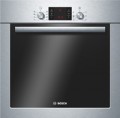Controls
The type of control panel installed in the oven. To date, there are such options:
—
Rotary knobsswitches. Controls based on classic rotary knobs, known to many users for other types of kitchen appliances — primarily classic cookers. This type of control can be found in both low-cost and advanced models: the specifics of the operation of ovens are such that many functions (both basic and additional) are conveniently controlled with rotary knobs and the simplest mechanical controls, and a complex electronic circuits. However, rotary knobs in their pure form are not used very often today — much more often they are combined with buttons or touch controls (see below).
—
Push-buttons. Push-button controls are typical of the electronic type and use complex control circuits, making this type of control suitable for models with a wide range of additional features. However, pure push-button controls, without rotary knobs, are very rare in ovens. On the one hand, for some functions, such controls are less convenient than rotary knobs; on the other hand, they are rather unusual for ovens, which can cause additional discomfort for the user.
—
Touch controls. They are in many ways similar to push-buttons (see above). The main difference between touch controls and buttons is that the touch controls respond to touch, not to press. Thanks to this, using such pane
...ls is much easier. In addition, the touch sensors give the device a stylish look and are easy to clean because they do not have protruding parts. Such controls in their pure form, not combined with rotary knobs, are also quite rare. However, for several reasons, there are still much more touch controls models than push-button ones.
— Rotary knobs with push-buttons. Control panels equipped with both rotary knobs and buttons. See above for more details on both. Here we note that the combination of two types of control allows not only to combine their advantages but also provides additional convenience: some functions of the oven can be tied to rotary knobs, others to buttons, linking each function with the type of control that is optimal for it. Due to this, this option is the most common today.
— Rotary knobs with touch controls. Combined control with rotary knobs and touch controls (see above for more on both). Like the “rotary knobs with push-buttons” option (also described above), it is very convenient because each function of the oven is tied to the type of control that is optimal for it — either to the rotary knob or to the touch controls. This option is much less common, but this is not due to inconvenience but primarily to the high cost of touch controls compared to push-buttons. Accordingly, it is used mainly in models of the middle and top classes.
— Pop out knobs. A variation of the rotary knobs described above, in which the knobs can be recessed into the control panel. Usually, pop out knobs are designed to stay outside only during the direct setting of the operating mode, and for the time when the oven is not in use or works in one mode, they can be hidden. It gives the unit a neat appearance, reduces the places where dirt can accumulate and makes the front panel easier to clean. Unlike rotary knobs, pop out knobs are mainly used in electrical models.
— Pop out knobs with push-buttons. Controls combining Pop out knobs with push-buttons. Both of these types of controls are described above, and in itself, this option is almost the same as a combination of buttons with rotary knobs (also see above).
— Pop out knobs with touch controls. A variant, by the name, combines pop out knobs and touch controls. Each of these types of control is described separately above, and their combination is almost no different from the combination of rotary knobs with touch controls (also see above). Except with the correction that recessed knobs keep the number of protruding elements on the control panel to an absolute minimum.Cooking temperature
The cooking temperature range allows you to understand which special tasks are subject to the oven. The lower temperature from which the oven starts heating, usually, is in the range of +30 to +50 ˚C. So, for example, the minimum heating temperature at
+30 ˚C allows you to defrost products. Models with a minimum of
40 ˚C and
50 ˚C allow you to heat ready meals, heat tableware (before serving), dry crackers, etc.
Connected load
The electrical power consumed by the oven during operation, in other words, the power that must be supplied to the oven so that it can work normally. This parameter determines not only the total energy consumption (and, accordingly, the amount of electricity bills) but also the specifics of the power supply: with a power consumption of several kilowatts, a conventional outlet may not be suitable, and the wiring must be quite reliable.
Note that it is customary to indicate the connection power only for electric models (see "Oven"), as well as for gas devices with electric grills.

